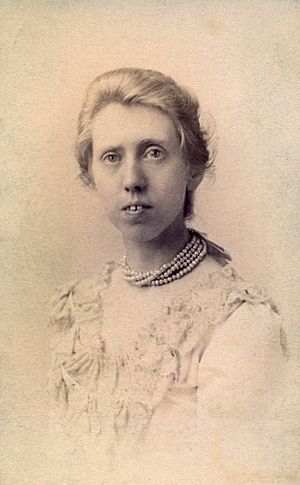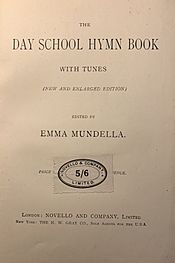Emma Mundella facts for kids
Quick facts for kids
Emma Mundella
|
|
|---|---|
 |
|
| Born | 30 April 1858 |
| Died | February 20, 1896 (aged 37) |
| Occupation | Composer, pianist, organist, conductor, music teacher and editor |
| Known for | The Day School Hymnbook |
| Relatives |
|
Emma Wright Mundella (born April 30, 1858 – died February 20, 1896) was a talented English musician. She was a composer, a pianist who gave concerts, and an organist in churches. Emma also led choirs, taught music, and edited hymn books.
Even though she lived a short life, she created many musical pieces. These included songs, hymns, and music for piano. She also wrote longer works like anthems and cantatas. Emma was the Director of Music Teaching at Wimbledon High School for Girls. She really wanted young people to enjoy and understand music. Because of this, she wrote many songs and pieces for children and schools. Today, her music is not often heard. But she is remembered for editing The Day School Hymnbook. A bigger version of this book came out after she died. This made her famous across the country.
Contents
Emma's Early Life and Schooling
Emma Mundella was born in Nottingham, England. She was the first of eight children in her family. Her father, John Mundella, made hosiery (like socks and tights). He passed away when Emma was 15 years old.
Her uncle was Anthony John Mundella. He was a well-known politician from the Liberal party. He was even part of the government under William Ewart Gladstone. Emma's family believed in the Unitarian faith. They also strongly supported education and making schools better.
Emma went to a school linked to the Unitarian High Pavement Chapel in Nottingham. She loved music from a young age and was very good at it. Her mother first taught her piano. Later, she learned from Arthur Page, the organist at St Mary's Church, Nottingham. He taught her piano and how music is put together (harmony).
How Emma Trained in Music
When Emma was 18, she won a special scholarship. It was worth £40 a year from the city of Nottingham. This allowed her to study at the new National Training School for Music in London. This school later became the famous Royal College of Music.
She was one of about 50 young people to get these first scholarships. The school opened on May 17, 1876, just as she arrived.
The head of the school was the famous composer Sir Arthur Sullivan. He taught Emma, along with other great musicians. These included pianist Ernst Pauer and composer Sir John Stainer. Emma studied piano, organ, harmony, and how to compose music. When the school changed to the Royal College of Music in 1883, she earned a special diploma. It was called Associate of the Royal College of Music (ARCM).
Emma as a Teacher
Emma wanted to teach music as well as compose it. After finishing college, she looked for jobs in schools. Her first job was in 1879. She became the Director of Music at St Elphin's Clergy Daughters' School in Warrington, Cheshire. There, she oversaw piano and harmony lessons. She also led classes for singing in choirs.
In November 1880, she was asked to lead music teaching at the new Wimbledon High School for Girls. This was a great fit for her. The school became known for its excellent music program. Emma stayed at Wimbledon for 16 years, until she died in 1896.
At the school, she did more than just teach regular music classes. She started talks about music topics. She also organized concerts and created a music club. This club was for students, both current and past. It helped them try composing and performing music. Emma also wrote music for the girls to perform.
Many of her former students loved her very much. They stayed friends with her long after leaving school. Katharine Ramsay, who later became Katharine Stewart-Murray, Duchess of Atholl, was one of her students. She wrote in her book that Emma was an amazing teacher. She said, "In music I had a teacher who I do not believe had her equal throughout the country, Miss Emma Mundella."
Emma as a Performer
Besides her school work, Emma Mundella was also a concert pianist. In the autumn of 1884, she gave a concert. It was entirely dedicated to the piano music of Edvard Grieg. This showed how skilled and strong she was as a musician.
She also played the organ at a church in London. Emma taught many private music students. She gave popular talks about famous composers. She even started and led a choir for women.
Emma had many friends in the music world. These included leading composers and musicians of her time. She was not afraid to ask important people for help or advice. For example, she wrote to Edvard Grieg before her 1884 concert. She asked him about the right speed for his piece, Norwegischer Brautzug (the Norwegian Bridal Procession). She went to many concerts. Her name often appeared as someone who helped support the Philharmonic Society's concerts. These concerts were held at St James’s Hall and later the Queen’s Hall.
Emma as a Composer
As a composer and teacher, Emma Mundella noticed something. There wasn't enough good music for young students to learn as they got better. She tried her best to fix this problem. For over 15 years, starting in 1881, she wrote many pieces especially for young people. These included cantatas, anthems, hymns, and songs for children.
One example of her work for young people is Through Wisdom Is An House Builded. This anthem was written for the opening of a new school building at Wimbledon. The school choir sang it, and Emma Mundella conducted it. She also wrote simple piano duets for teachers and students. Many other pieces were for adults. These included choir music, songs, and pieces for solo piano. Her choir music and songs were usually written for female voices.
Her main music publisher was Novello, Ewer and Company. Even after World War II, some of her works were still sold and performed. These included her version of William Shakespeare's Ye Spotted Snakes.
The Day School Hymnbook
Emma Mundella's most important work was The Day School Hymnbook. It was published by Novello and Company in London in 1890. The first edition had 83 hymns. The Musical Times newspaper said it was very well-liked. It showed that Emma was great at choosing words and music that young people would love. Novello and Company asked her to make a much bigger second edition.
The second edition came out in 1896, after Emma's death. Like the first, it was for everyone, no matter their religion. It included about 100 more hymns. Some even had their French, German, and Latin words. Emma wrote new music for 15 hymns that already existed. She also asked her composer friends, like John Stainer and Hubert Parry, to add their own music. She also included her versions of music by composers like Robert Schumann and Franz Schubert.
When The Musical Times reviewed this second edition, they said:
The wide reading and the musical knowledge it displays are remarkable; here are old German, French, and English tunes, and many too-much neglected tunes of the English middle period ... the special contributions of living composers show how many of her friends took a sincere interest in the success of the work ... Among the many tunes which here appear for the first time, some of the most remarkable are from her pen.
The Day School Hymnbook can still be found today as digital copies.
Emma's Personal Life and Early Death
We don't know much about Emma Mundella's personal life. We know she loved music and had many friends in the music world. She also stayed close with her former students. She never married. She lived in Bloomsbury, London, with her younger brother. He was Anthony John Mundella (Junior), a journalist and education reformer.
Emma died in Marylebone, London, on February 20, 1896. She passed away due to an illness. She was buried in her family's burial place in Nottingham.
Emma Mundella's friend, the composer Sir John Stainer, wrote about her after she died. He said:
The secret of her extraordinary success and influence lay in the fact that she loved always to do her best because work was to her a privilege as well as a pleasure, and also because she did not teach others from the height of a professional pedestal; she was down amongst their hearts with a loving penetrating sympathy.
Emma Mundella's Works
This is a list of some of Emma Mundella's musical works, ordered by when they were published. All her works are no longer printed. Copies of most of them are kept by her family. Many copies are also held by the British Library in London and the Bodleian Library in Oxford.
- The Holidays - A "breaking-up" Song. (1881)
- Blessed be the Lord God - A Christmas Anthem. (1883)
- Autumn, song. (1883)
- Twelve Children's Songs for Elementary Classes. (1886)
- Flowers, canon for two voices. (1886)
- Ye Spotted Snakes, two-part song. (1886)
- Our God is Lord of the Harvest, anthem. (1886)
- Song of the Mermaids and Mermen, two-part song. (1886)
- The Mad Lover's Song, song. (1886)
- Through Wisdom is an House Builded, two-part anthem. (1887)
- Andante and allegro con brio, for violins and pianoforte. (1888)
- March and chorus from Wagner's Tannhäuser. Arranged for piano and female voices. (1890)
- Twelve Elementary Duets. (1890)
- The Victory of Song, chorus for female voices. (1891)
- Autumn Leaves, cantata for female voices. (1892)
- What the Birds Said, two-part song. (1893)
- Up and Down, two-part song. (1893)
- Praise, O Praise our God and King. (1894)
- Untitled hymn tune, written on All Saints' Day. (1895, published 1896)
- Antigone, musical, performed by Wimbledon High School girls. (1896, not published)
- Dreamland, choral piece. (1896, not published)
- Several hymn tunes in The Day School Hymn Book, 2nd edition (1896): Simplicitas, St Mary, Kilvington, Ex Humilibus Excelsa, Hengwrt, Carrington, St Catharine, St John, Nottingham, Étoile du Matin, Prière du Soir, Confiance en Dieu, Consécration, Glorification.
- Three School Graces, unaccompanied score. (1896)
- The Desert, carol. (Published 1899)
- Journeying, song. (Published 1903)
- A River Song, song. (Published 1903)
- Three Sketches for the Pianoforte. (No date)


